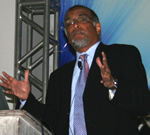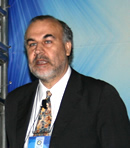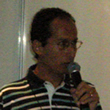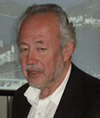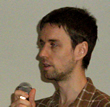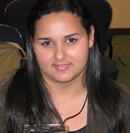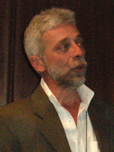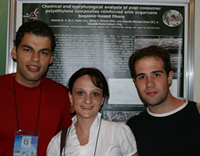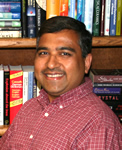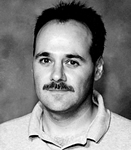
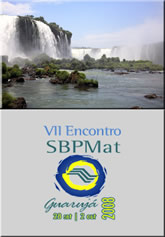


SPI Supplies
Silicon Nitride Membrane
Window Grids

MMR Technologies
Microcryogenic
and
Thermal Stage Systems

National
Electrostatics Corp.
Ion Beams
RBS, PIXE,
AMS

Huntington Mechanical Labs
Better-Built Vacuum Components

Goodfellow
Small quantities … fast!
|
DAY 4
CONTENTS
The 7th Brazilian MRS Meeting (VII Encontro SBPMat) 2008 completed its fourth and penultimate day. The last three plenary lectures of the meeting were the major highlight of the day, which also included the final poster session, the exhibit and various technical sessions.
PLENARY LECTURE 7: GEHAN A. J. AMARATUNGA Nanocomposites for Photovolatic Energy Harvesting
Gehan Amaratunga, from Cambridge University, UK, presented the seventh plenary lecture and described his group’s ongoing research using nanocomposites for photovoltaic (PV) energy harvesting. Distinct from PV energy generation, which is an established technology growing at a rate of 50% per year as an alternate to conventional electricity generation, PV energy harvesting is envisaged as employing inexpensive technologies to capture light energy in low-light environments unsuitable for conventional, silicon-based PV devices. For example, implementation on flexible substrates, such as fabric and flexible plastic, through processes such as painting and printing could power autonomous sensing and communication electronics using ambient, fluorescent light. These possibilities have come about due to the ability to synthesize nanoscale inorganic semiconductors, such as ZnO, FeO, TiO, Si, GaAs and Ge, and combine them within a polymer. The PV surface is essentially an ensemble of nanoscale PV cells acting to yield an average terminal voltage and current over a defined area. Amaratunga said that energy conversion and local storage is more important than power conversion efficiency because the environmental light source has a much lower intensity than sunlight. Amaratunga presented a transparent PV cell fabricated by dispersing single-walled carbon nanotubes (SWNTs) onto a transpatent substrate and then growing ZnO nanowires over them using the hydrothermal method. Another PV cell was fabricated by growing ZnO nanowires on a fabric composed of electrospun carbon fiber. A black dye was included to enhance light absorption. Considering the reverse process, Amaratunga fabricated ZnO-SWNT composite light-emitting diode, which displays a strong monochromatic emission at 450 nm. Amaratunga speculated that the source of this emission had to do with defect sites in ZnO nanowires that might act as cavities for light amplification. PLENARY LECTURE 8: ENRICO TRAVERSA Materials for a Sustainable Development: The Key Role of Nanostructure
Enrico Traversa (Università di Roma “Tor Vergata”, Rome, Italy) started his plenary presentation by discussing the current energy situation in the world. It is clear from an environmental and sustainability view-point that alternate energy sources need to be used. Another interesting dynamic is that the overall population around the world is aging, meaning there are larger number of older people, who will require adequate health care in the future. For solutions to these problems, materials will play a key role with required improvements in performance. The approach followed by Traversa's research group is to find nanostructured materials with innovative characteristics. He described three different applications as examples, gas sensors, fuel cells and tissue engineering, covering the environment, energy and health areas respectively. For gas sensing applictions, he described reducing the size of semiconducting metal oxides to increase sensitivity of sensors. For example, the gas responses of titania-based gas sensors are strongly dependent on particle size. He also discussed Pt|YSZ|Pt|Nb2O5and Pt|YSZ|Nb2O5 sensors for on-board diagnostics in automobiles. These are being used for monitoring the output to comply with increasingly stricter European standards for emissions. Next, Traversa discussed SOFCs, which are very promising for stationary energy production applications. Currently, the availability of SOFCs is limited by the high operation temperature (1000°C) of commercial cells, needed due to the use of yttria-stabilized zirconia (YSZ) as solid electrolyte. It is necessary to reduce the temperature below 700°C to overcome this. One of the tricks is to use nanostructured materials for the electrodes. He described the development of nanostructured materials for the electrolyte, cathode, anode and protonic conductors. He also described miniaturizing SOFCs for applications at lower temperatures using pulsed laser deposition for forming thin films. Finally, Traversa described some recent work in his group on tissue engineering of cardiac tissue. This requires mm scale, micron scale and nanoscale structures all within the same single structure. He concluded by suggesting that it is possible to be optimistic about the future and that we will overcome all of these energy and sustainibility challenges.
PLENARY LECTURE 9: FERNANDO COSME RIZZO ASSUNÇÃO A Prospective Study of Advanced Materials
In the ninth and final plenary talk of the conference, Fernando Rizzo, Director of CGEE (the Center for Strategic Analysis and Study, roughly translated), Brazil, outlined and gave examples of prospective studies on advanced materials. He first gave a brief overview of CGEE, which was established seven years ago. Its mission is to subsidize the policy and strategic management in the areas of science, technology, and innovation. Each project goes through four phases – information, knowledge, commitment, and strategy – in order to develop a vision for the future. The growing importance of advanced materials in everyday life, as well as substantial advances in new and existing technologies, has stimulated CGEE to develop a series of prospective studies aimed at increasing the competitiveness of the materials science industry and the rational utilization of natural resources in Brazil. The main goal of these studies is to provide direction for future research and development through a collective decision making process with involvement from academe, government, and industry. The results of these studies have been incorporated into technological roadmaps for specific industrial sectors. Recently, a prospective study on advanced materials has been initiated with a time horizon of 2022. Prioritizing research and
development topics using criteria including potential return of
investment and the level of technical maturity in Brazil and the
world, seven themes were selected for advanced materials:
Symposium A: Novel Hybrid Organic-Inorganic
Multifunctional Materials
In an invited talk in Symposium A, K. Dahmouche, from the Institute of Macromolecules, University Federale Rio de Janeiro, showed how profoundly the nanostructural features of different types of organic-inorganic hybrids determine their properties. The nanostructures of hybrids prepared by the sol-gel method displaying ionic or electronic conductivity, magnetic properties, and good optical, mechanical, or adhesion properties, were investigated with small-angle x-ray scattering (SAXS). Dahmouche generally concluded that much more than optimizing the local or individual properties of each phase of the materials, nanostructural control is the key to improving the applicability of hybrid nanocomposites. Some examples of possible technological applications of a few hybrid families were presented, such as silica-modified SPEEK membranes, as possible replacement for commercial Nalfion membranes, epoxy-POSS hybrid materials, and Fe(II)- and Fe(III)-doped siloxane-PEO nanohybrids. Template effect on the formation of vanadium oxide nanostructures
G. Gonzalez, from the Universidad Tecnológica Metropolitana, Santiago, Chile, in his contributed talk first reviewed the interesting properties that make nanoparticles such a popular area of research. Of particular interest is the electronic structure of mixed valence oxides and self- assembling phenomena. He then described the preparation of vanadium oxide nanotubes using two different templates – long chain alylamines and alkythiols. In addition, both templates can lead to more complex 3D structures, depending on the preparation conditions. Gonzalez also discussed the role of the surfactant and the reaction conditions in the “roll-up” mechanism that transforms 2D laminar nanostructures into 1D nanotubes. Organized multilayered mesoporous core-shell colloids with tailored chemical groups
A. Wolosiuk reported on his research on organized multilayered mesoporous core-shell colloids with tailored chemical groups. The confined domains of cavities and pores allow modulation of electrical and optical properties as well as ways to control catalysis, sorption, and separation. Stober’s method was used to obtain silica core particles, while multiple layered mesoporous shell syntheses were performed using various alkoxy silane precursors and cationic surfactants as soft templates for pore formation. Wolosiuk was able to tailor the thickness and chemical composition of the mesoporous core shell colloids by varying the reaction conditions. He confirmed the results using FTIR, EDS, XPS, and TEM.
Symposium D: Powder Processing of Novel
Materials
In the Rio Grande do Norte state in Brazil, ceramics represent an important part of the local economy, exclusively producing roofing tiles, bricks and blocks of red ceramics. One of the interesting aspects of this is that the Rio Grande do Norte has various clays with natural coloration, yielding diverse oxides with a variety of colors including white, lilac, orange. As described by Narayanna M. Farreira (Centro Federal de Educacao Tecnologica do Rio Grande do Norte), the purpose of this work was to characterize these clays using porosity measurements, plasticity testing, thermal analysis, X-rays and Electronic Scanning Microscopy. Depending on the time and the temperature of sintering, characteristic colorations without the need to incorporate other oxides or subsequent ceramic dyes could be obtained. Subsequently, the ceramic powder is used as a liquid phase slurry in slip casting to form the ceramics. Sintering emperatures of 900ºC, 950ºC, 1000ºC and 1100ºC were used. Farreira showed examples of decorative and colorful ceramic pieces produced using these clays as the raw material. The colors of the clays were also correlated with the compositions. The clays maintained their natural colors upto sintering temperatures of 1100ºC above which changes in the color were observed.
Symposium J: Applications of Lasers in Materials
Processing
In an invited talk in Symposium J, R. Riva recounted some of the laser methods for materials processing developed at IEAv – the Institute for Advanced Studies, created in 1982. Under the Photonics research division (other divisions include Optics and Fiber Optic Sensors), Laser Research is divided into laser development, laser isotope separation, and materials processing. With nine PhD researchers, eight technicians, and 12 students (undergraduates and graduate students), Riva summarized the many accomplishments of his laboratory, including:
Symposium M: Electron Microscopy in
Industry
In a poster presented by Alberto G. V. de Carvalho-Neto, Silvia L. Fávaro, A. C. M. da Rosa, and E. Radovanovic of the Universidade Estadual de Maringá, PR, Brazil, the authors described forming composites using waste polyethylene (or as they called it, post-consumer PE) as the matrix and waste sugarcane fibers (bagasse fibers) as the reinforcement. Chemical modification of the sugarcane fibers was carried out to improve their compatibility and adhesion to the matrix using an NaOH solution followed by an acetylating reaction. The composites were prepared using an extrusion process with 5, 10 or 20 wt% of fibers. The morphology of the compsites was evaluated by SEM . The chemical modification of the fibers was clearly found to improve the adhesion between the matrix and the reinforcement fibers.
ABOUT THE MEETING SCENE
© Materials Research Society, 2008 |




